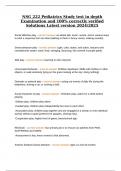Exam (elaborations)
NSG 222 Infant/children developmental stages Study test in depth Examination and 100% correctly verified Solutions Latest version 2024/2025
- Course
- Institution
NSG 222 Infant/children developmental stages Study test in depth Examination and 100% correctly verified Solutions Latest version 2024/2025 Social affective play - correct answer as adults talk, touch, nuzzle, and in various ways to elicit a response from an infant (talking to them in funny voic...
[Show more]



